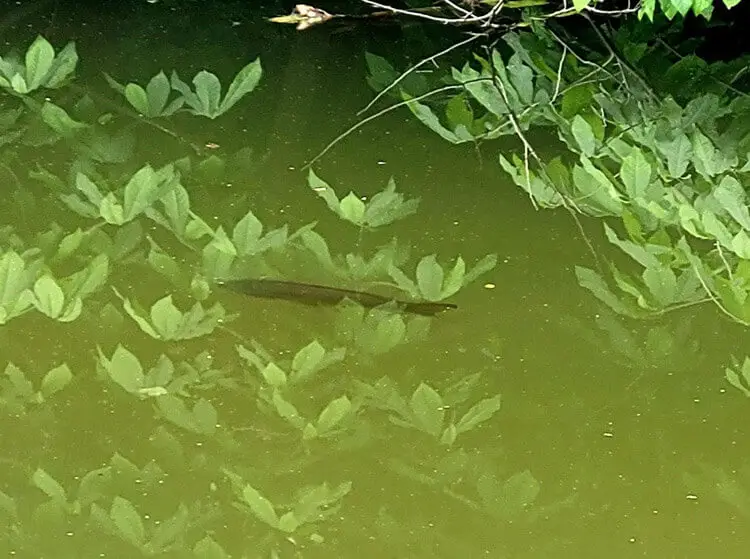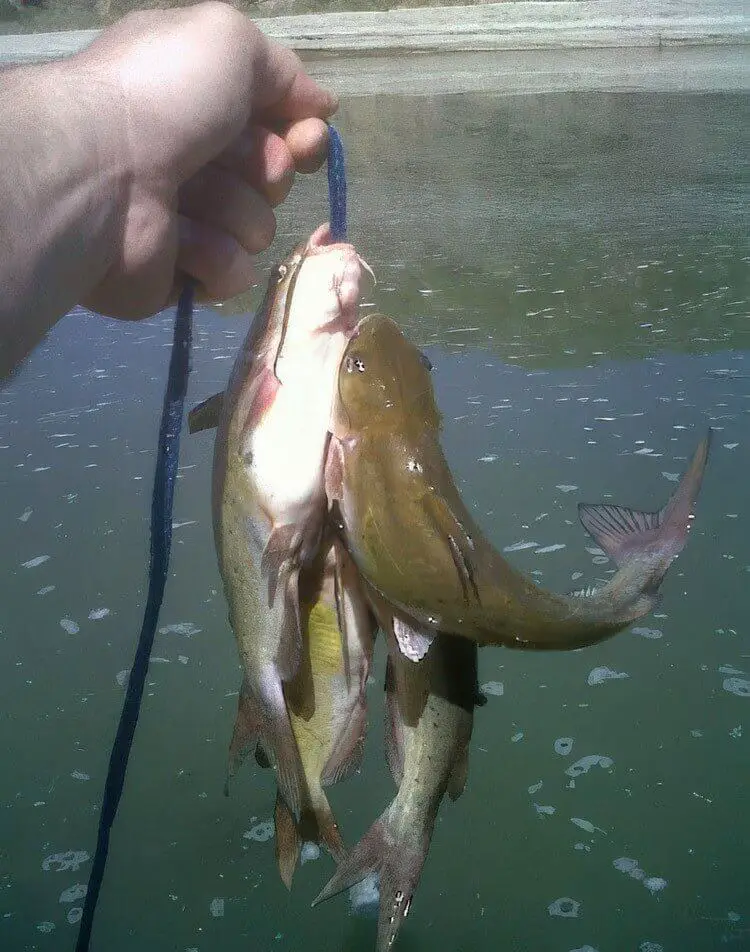When it comes to the underwater world of catfish, a diverse array of species awaits our culinary curiosity. Among them, channel catfish stands out as a true delight for seafood enthusiasts.
But are channel catfish good to eat? If you’ve ever wondered about the delectability of these aquatic creatures, you will have the correct answer!
The article will help you uncover why channel catfish are safe and delicious choices for your next meal. Let’s dive into the irresistible delights of the fish!
Table of Contents
What Are Channel Catfish?
Channel catfish is a species of catfish native to North America. They have distinctive appearances and feeding habits.
Appearance
These fish have grayish-blue sides, a white belly, and a black back. Yet, some may exhibit albinism, resulting in a lack of pigmentation.
Size
Mature catfish weigh from two to four pounds and measure around 12 inches. The largest recorded channel catfish weighed 58 pounds and lived in South Carolina.
Native Habit
Channel catfish gather the most in North America. You can find them in the continent’s lakes, ponds, and rivers.
Eating Habits
Channel catfish are bottom-dwelling omnivores. They use their fantastic senses of taste and smell to locate food, especially in muddy and dark waters.
These fish can eat a wide variety of items. Their favorite food includes insects, plants, algae, and other small organisms.


Are Channel Catfish Good to Eat?
The correct answer is Yes. Channel catfish offer various health benefits. However, you need to expect some risks related to environmental factors.
Benefits
First, let’s discuss the fish’s nutritional value. Here is what you can get from a filet of channel catfish:
- Calories: 215
- Fat: 12.7g
- Carbs: 0g
- Protein: 24.72g
Channel catfish are not only tasty but also good for your health. The following reasons make them attractive to fish lovers:
High Protein
Channel catfish is an excellent source of protein, which plays a vital role in the growth, repair, and maintenance of our body tissues. This nutrient is also crucial for supporting the immune system and producing enzymes.
Low Calorie
These fish are lower in calories than many other meat sources. So if you want to manage your weight or follow a calorie-restricted diet, you will love them.
Low Fat
The low-fat content makes channel catfish a healthier alternative to fatty meats. They help reduce the risk of cardiovascular diseases.
Essential Vitamins
Channel catfish contains essential vitamins that are important for overall health. For example, the fish’s vitamin D content helps with bone health.
Additionally, channel catfish are a good source of vitamin B12. Your nerve function and production of red blood cells can benefit from them.


Risks
Some people choose not to eat channel catfish because of concerns about the local environment. Meanwhile, others avoid it due to incorrect beliefs about how these fish feed.
In fact, channel catfish are bottom feeders and eat a variety of things. However, it’s not a fair judgment because catfish swim in the same water and eat prey like other popular freshwater fish.
So, channel catfish may have contaminants like PCBs and mercury. Yet, other fish in the same area will have them too. So, it’s more of an environmental problem rather than a problem specific to the feeding habits of channel catfish.
In general, like other bottom feeders, channel catfish may pose some risks to your health. Here are the top considerations before trying them:
Mercury
Channel catfish may contain mercury, a naturally occurring heavy metal. Unfortunately, it’s harmful to human health in high amounts.
Mercury accumulates in the bodies of fish over time because of their messy diet. Thus, you should limit the consumption of fish. Pregnant women, nursing mothers, and kids are the most prone to them.
PCBs
Polychlorinated biphenyls (PCBs) are industrial chemicals. Because of their harmful effects on the environment and human health, many governments have banned them.
However, PCBs can still be present in certain bodies of water. And channel catfish may accumulate these chemicals.
Antibiotics
Aquaculture settings sometimes treat channel catfish with antibiotics to prevent or treat diseases. Sadly, the use of antibiotics in fish farming can contribute to the development of antibiotic resistance.
As a result, be aware of the source of the catfish. Only choose sustainably farmed fish with minimal use of antibiotics.


What Do Channel Catfish Taste Like?
The taste of channel catfish can vary slightly depending on personal preferences and the cooking method. But overall, they taste good.
- Texture: The firm white meat of channel catfish is similar to that of walleye and trout, although it is not as flaky. You may also love the moist, dense flesh as it remains juicy when cooked.
- Smell: People enjoy eating channel catfish because they don’t have a strong fishy or gamey taste. These issues are common in salmon and tuna.
- Flavor: Channel catfish are also famous for their sweet flavor, similar to smallmouth bass.
What Size of Channel Catfish Taste Best?
The size and maturity of channel catfish affect their taste. They often taste best when fully mature but not too old.
Older channel catfish can grow to be very big. However, the smaller ones may have a better flavor because of the more edible tissues. In fact, fish that exceed the six to eight-pound range often have a lot of inedible fat.
Unlike the fat in red meat, catfish meat is yellow and doesn’t have a nice taste. Hence, while reeling a big channel catfish can be exciting, you’d better release them since they don’t taste as good.
Experienced anglers agree on the sweet spot for the best-tasting channel catfish, which is in the two to four-pound range. It generally corresponds to an 18-24 inch fish.


How to Prepare Channel Catfish
You must carefully clean and filet your channel catfish before choosing the best cooking method. Here are the three-step instructions to follow:
Step 1: Clean the Fish
Start by cutting off the head of the catfish. Use a sharp fishing knife to make a clean cut just behind the gill plates. This step helps to facilitate further cleaning.
Then, create a slit on the fish’s belly side, then remove all of its guts. Fishing pliers can help you perform this step with ease.
After that, scale the channel fish using suitable tools. If you don’t have any, your fingernails can do the task.
Once you remove the internal organs, soak your channel catfish in salt water for about 25 minutes to prevent bacterial growth.
Step 2: Fillet the Fish
Fileting the fish requires a lot of attention. So follow these steps to do it properly:
- Imagine drawing a line from the top to the bottom and making the first cut, avoiding the head.
- Keep cutting until you reach the backbone, then turn the knife toward its tail.
- Stop cutting before touching the tail to make it easier to separate the flesh from the skin.
- Flip the filet over the tail, then gently cut between the skin and the meat using a regular knife.
- Repeat the steps on the other side of the fish.
- Take out any remaining yellow fat and rib cage from the filet.


Step 3: Cook the Fish
You can cook channel catfish in various ways, but the popular methods are frying or baking the fish.
- Catfish Po’Boys: This tasty Cajun sandwich is simple to make. Just bake or fry the catfish filets and place them on a bread roll. Then, add tomato, pickle, lettuce, hot sauce, and mayonnaise.
- Catfish Gumbo: This dish contains flour, celery, seasonings, bell peppers, onions, and seafood or chicken stock. You can also add other ingredients to the gumbo.
- Baked Fish: Rub the filets with chili powder, cayenne, cumin, and paprika. Then, bake and serve it with salad.
Related: Fried catfish with flour no cornmeal
What Type of Catfish Tastes Best?
Not all catfish taste the same because their flavor depends on what they eat. Aside from the tasty channel catfish, other species can give you a good dining experience.
Flathead Catfish
The yellow body and wide, flat head make flathead catfish easily recognized. And like channel catfish, they are not picky eaters.
Many people find flathead catfish delicious as long as they don’t taste muddy. You will appreciate their sweet and mild flavor, too.
Blue Catfish
The meat of blue catfish is flaky and firm without any fish taste. Yet, you may notice a nasty taste when the mercury in the water permeates the meat.
Besides, blue catfish can bring out a terrific flavor depending on the water’s quality. They like to feed on tiny fish instead of seeking debris.
Bullhead Catfish
Bullhead catfish live in muddy environments. Due to their habitat and feeding habits, their meat can sometimes have a muddy taste.


FAQs
Are Channel Catfish Poisonous?
Although these fish are not poisonous, they have spines on their pectoral and dorsal fins that carry mucus. If these spines puncture the skin, they can result in an infection.
Are Channel Catfish High in Mercury?
No. Catfish have one of the lowest mercury levels, measuring around 0.056 ppm (parts per million). So while it’s important to be aware of high-mercury fish and limit their consumption, you do not have to avoid channel catfish altogether.
How to Catch Channel Catfish
Start by choosing the right tools to check channel catfish. The best options include the following:
- Rod: Short rods for fishing in lakes and longer ones for streams.
- Reel: Light-duty reels are enough if you intend to catch small fish. On the other hand, the heavy-duty ones can help you catch larger fish.
- Bait options: Liver, leeches, nightcrawlers, minnows, and stink baits work best for channel catfish.
After setting up your fishing rod, present the bait naturally. Remember to pay attention to the water flow and rising levels for better activity.
What Is the Difference Between Catfish and Channel Catfish?
You can look at the anal fins of catfish to name their species. For example, blue catfish have more than 30 rays on their anal fin, while channel catfish have fewer than 30.
Is the Yellow Meat on a Channel Catfish Good to Eat?
The yellow color in the meat of a channel catfish comes from their natural foods. It doesn’t taste good but is safe to eat.
Conclusion
With their mild and sweet flavor, channel catfish offer a delectable seafood experience that you can’t resist.
So, don’t hesitate to add them to your next meal! If you need more cooking tips, please feel free to reach us for help.
Thank you for reading!















I beloved up to you will obtain carried out right here. The sketch is tasteful, your authored subject matter stylish. however, you command get got an nervousness over that you want be handing over the following. in poor health for sure come further beforehand once more as exactly the similar nearly very incessantly inside case you protect this hike.
Thank you for your sharing. I am worried that I lack creative ideas. It is your article that makes me full of hope. Thank you. But, I have a question, can you help me?